“Worth every penny!” says Neill Morrison about his new 3-D model…
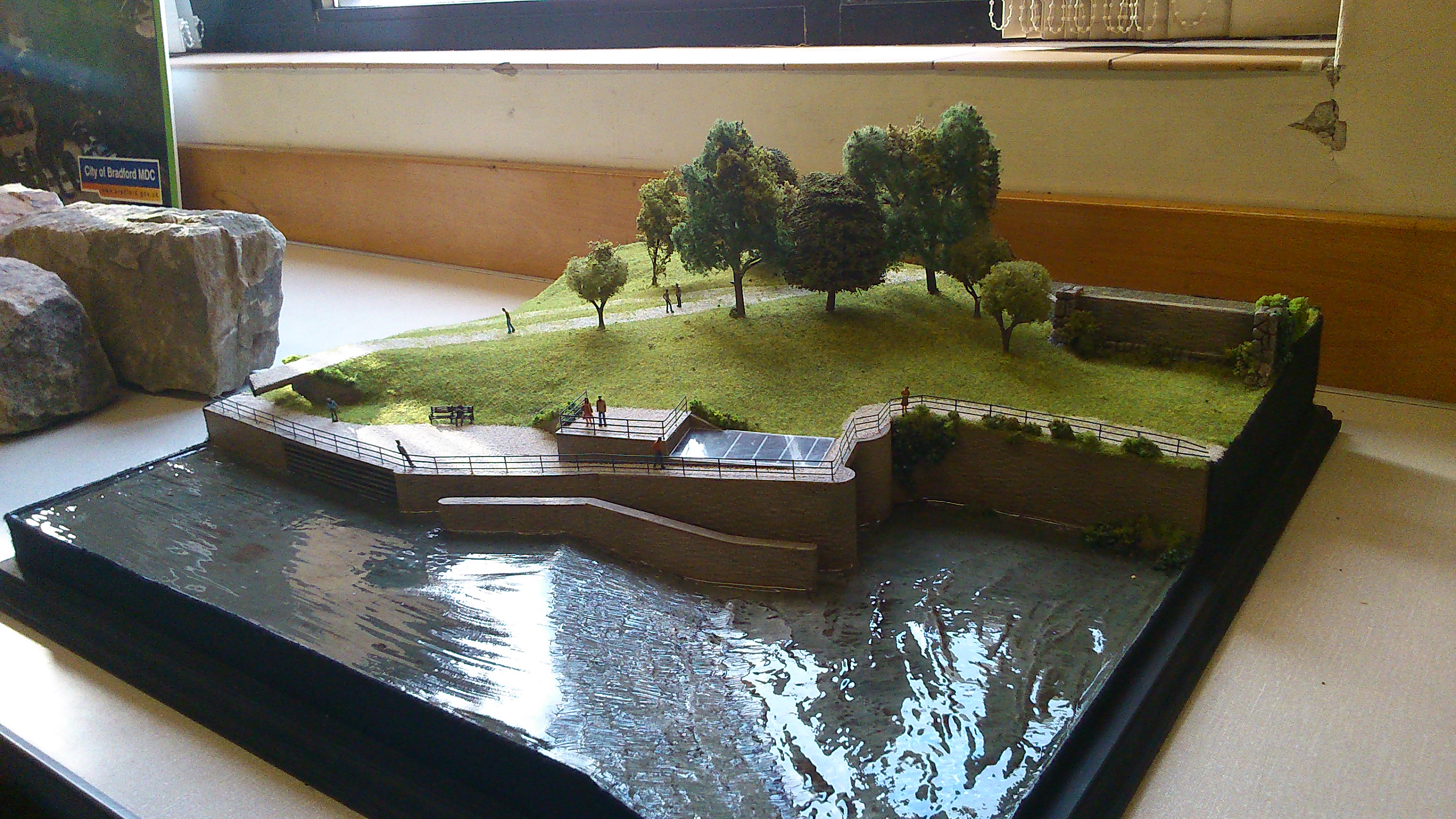 This is a model-maker’s rendering of what the Baildon side of Saltaire weir might look like after the completion of Bradford Council’s planned hydro-electric turbine installation. It was on display today (and will be again tomorrow) at Shipley Library, as part of a public consultation about the scheme. Neill Morrison, who has been leading work on the project since its inception, for the Council’s energy and climate change department, feels that the 3-D approach gives a much more accurate and friendly-looking impression of the scheme than the computer-generated graphics used at the last such consultation exercise — at Saltaire’s URC church back in July 2012. At that stage, plans for the scheme were still in their developmental stages, but a lot of the opposition generated that summer (previously discussed on this blog here and here) seems to have been sparked more by a dislike of the first-stage artwork than by the substance of the plans. Neill’s team have carefully redesigned the look of the planned installation, to make the buildings housing it lower and less obtrusive in the 2D graphics (at the consultation, you could compare the old and new impressions, to see how much had changed). But I tend to think he’s right, also, that the 3D model helps. It has little people figures in it, and pretend grass that you sort of want to touch, and it reminds you of your uncle’s Hornby train set. So much more ‘human’, somehow, than computer graphics…
This is a model-maker’s rendering of what the Baildon side of Saltaire weir might look like after the completion of Bradford Council’s planned hydro-electric turbine installation. It was on display today (and will be again tomorrow) at Shipley Library, as part of a public consultation about the scheme. Neill Morrison, who has been leading work on the project since its inception, for the Council’s energy and climate change department, feels that the 3-D approach gives a much more accurate and friendly-looking impression of the scheme than the computer-generated graphics used at the last such consultation exercise — at Saltaire’s URC church back in July 2012. At that stage, plans for the scheme were still in their developmental stages, but a lot of the opposition generated that summer (previously discussed on this blog here and here) seems to have been sparked more by a dislike of the first-stage artwork than by the substance of the plans. Neill’s team have carefully redesigned the look of the planned installation, to make the buildings housing it lower and less obtrusive in the 2D graphics (at the consultation, you could compare the old and new impressions, to see how much had changed). But I tend to think he’s right, also, that the 3D model helps. It has little people figures in it, and pretend grass that you sort of want to touch, and it reminds you of your uncle’s Hornby train set. So much more ‘human’, somehow, than computer graphics…
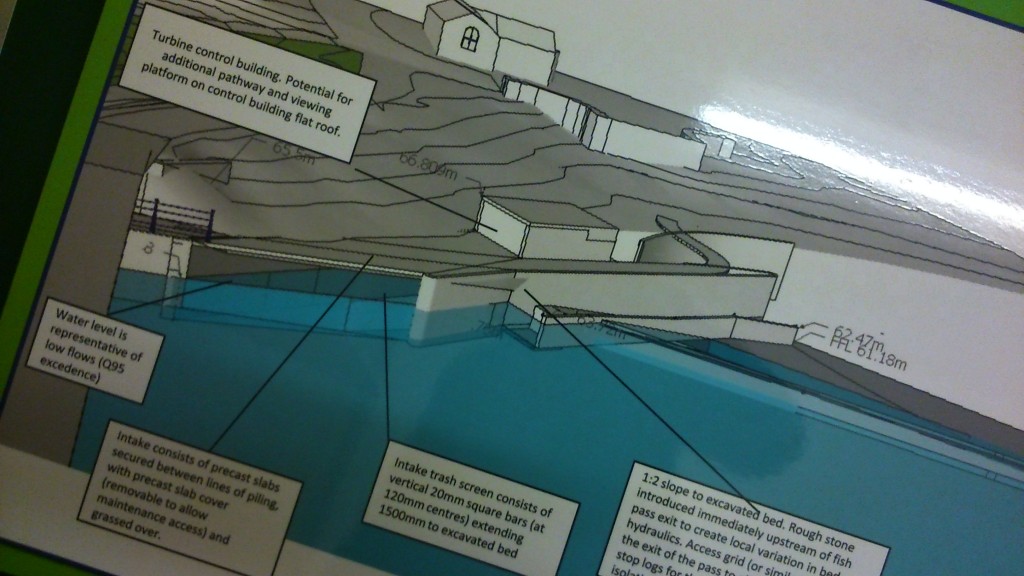 This is one of the more technical renderings of the new plans – in which talk of such things as “Q95 excedence” (see far left) might be prone to make even the most enthusiastic supporter of renewable energy glaze over a bit. But even this graphic gives you a useful sense of the depth of the river in relation to the contours of the land, and confirms the generally modest intrusion into the landscape of the installation itself. Meanwhile, for those who really want to get into technical detail, the consultation gave you the opportunity to read (or even take away) a chunky report from independent sound pollution consultants — which basically demonstrated that the noise from the hydro will be at such low levels that even close up to it you’ll be hard pressed to hear its workings over the other environmental sounds in the area (e.g. the river). The sound will be at a different frequency, operating at a decibel level well below other factors in the area. So you really will be able to take a nice stroll along the river bank, and peer down at the screw through the installation’s picture windows, and feel curious rather than oppressed…They’re starting to think now about the interpretation boards that might accompany the housing — as befits a feature designed for a World Heritage Site. And the actual ‘consultation’ part of this consultation involved asking the public about details such as the extent of railings to be used on the site, what substance should cover the roof of the machine house (turf, astroturf, gravel…), and so forth. They’re definitely into the fine details now…
This is one of the more technical renderings of the new plans – in which talk of such things as “Q95 excedence” (see far left) might be prone to make even the most enthusiastic supporter of renewable energy glaze over a bit. But even this graphic gives you a useful sense of the depth of the river in relation to the contours of the land, and confirms the generally modest intrusion into the landscape of the installation itself. Meanwhile, for those who really want to get into technical detail, the consultation gave you the opportunity to read (or even take away) a chunky report from independent sound pollution consultants — which basically demonstrated that the noise from the hydro will be at such low levels that even close up to it you’ll be hard pressed to hear its workings over the other environmental sounds in the area (e.g. the river). The sound will be at a different frequency, operating at a decibel level well below other factors in the area. So you really will be able to take a nice stroll along the river bank, and peer down at the screw through the installation’s picture windows, and feel curious rather than oppressed…They’re starting to think now about the interpretation boards that might accompany the housing — as befits a feature designed for a World Heritage Site. And the actual ‘consultation’ part of this consultation involved asking the public about details such as the extent of railings to be used on the site, what substance should cover the roof of the machine house (turf, astroturf, gravel…), and so forth. They’re definitely into the fine details now…
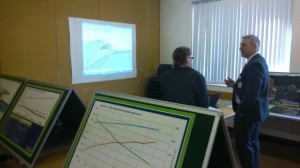 All in all, it’s actually quite hard at this point to know what one could possibly object to with the scheme. Apparently someone from the Telegraph and Argus turned up to cover the event today, and was a little disappointed not to find anybody – even during the lunch time ‘rush’ period – who wanted to voice any opposition to the scheme. I dare say there will be objections, of course, perhaps to the temporary disruption that will inevitably be caused by the build itself — but that will take up to 26 weeks, Neill told me, not the 26 months reported by some of the scheme’s opponents. And the build won’t in any way disrupt the Saltaire Festival: if planning permission is granted, they’ll either start building in the new year and have it finished by the summer, or (should a lot of objections need to be countered) they’ll start building next autumn after the Festival.
All in all, it’s actually quite hard at this point to know what one could possibly object to with the scheme. Apparently someone from the Telegraph and Argus turned up to cover the event today, and was a little disappointed not to find anybody – even during the lunch time ‘rush’ period – who wanted to voice any opposition to the scheme. I dare say there will be objections, of course, perhaps to the temporary disruption that will inevitably be caused by the build itself — but that will take up to 26 weeks, Neill told me, not the 26 months reported by some of the scheme’s opponents. And the build won’t in any way disrupt the Saltaire Festival: if planning permission is granted, they’ll either start building in the new year and have it finished by the summer, or (should a lot of objections need to be countered) they’ll start building next autumn after the Festival.
 Here’s the valiant team from the Council battling disinformation at Shipley Library. Neill on the left, with his colleagues Kate and Tom, who all seem very committed to the project. The hydro, I’m told, will cost up to £1.5 million to construct, and should pay for itself within 10-12 years — although the currently volatile price of energy, Tom points out, will inevitably affect the length of time it takes to recoup costs. As for the rumour mill’s claims that the scheme has cost council tax payers around £1 million in consultancy fees (I’ve heard this claim put forward quite seriously), Neill blinked in bewilderment when I mentioned this figure. The true sum, he says, has been around £60 – £70,000.
Here’s the valiant team from the Council battling disinformation at Shipley Library. Neill on the left, with his colleagues Kate and Tom, who all seem very committed to the project. The hydro, I’m told, will cost up to £1.5 million to construct, and should pay for itself within 10-12 years — although the currently volatile price of energy, Tom points out, will inevitably affect the length of time it takes to recoup costs. As for the rumour mill’s claims that the scheme has cost council tax payers around £1 million in consultancy fees (I’ve heard this claim put forward quite seriously), Neill blinked in bewilderment when I mentioned this figure. The true sum, he says, has been around £60 – £70,000.
So anyway, inspired by this consultation exercise, I subsequently took myself down to Baildon Bridge to indulge in a little unofficial consulting of my own…
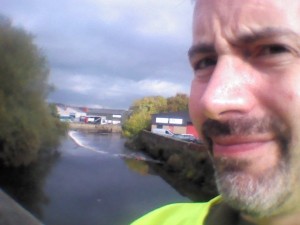 Here I am in a dubious ‘selfie’, standing on the bridge, with Shipley weir in the background… This is the less contested weir in the area, somewhat neglected and largely ignored by comparison with the one just upstream at Saltaire. But as has reported previously on this blog, some folk at the local working men’s club (just on the upstream side of the bridge) have argued for this weir’s removal. The suggestion is that, in keeping the water level artificially high as it comes under the bridge, the weir increases flood risk in the area (not least to the club), and it’s certainly the case that this bridge is the major flooding pinch point in Shipley — as it easily becomes dammed up with debris in high water… Anyhoo, point is, it’s been suggested to me that any talk of removing this weir would likely spark local opposition from those who see it as part of the area’s industrial heritage (there was a mill on the Baildon side of the river here probably since the 13th century…), or who like the aesthetic of the wide, curving structure. So today I decided to (unscientifically) test the waters a little by asking passers by what they thought of the weir and whether it would make any difference to them if it wasn’t there any more…
Here I am in a dubious ‘selfie’, standing on the bridge, with Shipley weir in the background… This is the less contested weir in the area, somewhat neglected and largely ignored by comparison with the one just upstream at Saltaire. But as has reported previously on this blog, some folk at the local working men’s club (just on the upstream side of the bridge) have argued for this weir’s removal. The suggestion is that, in keeping the water level artificially high as it comes under the bridge, the weir increases flood risk in the area (not least to the club), and it’s certainly the case that this bridge is the major flooding pinch point in Shipley — as it easily becomes dammed up with debris in high water… Anyhoo, point is, it’s been suggested to me that any talk of removing this weir would likely spark local opposition from those who see it as part of the area’s industrial heritage (there was a mill on the Baildon side of the river here probably since the 13th century…), or who like the aesthetic of the wide, curving structure. So today I decided to (unscientifically) test the waters a little by asking passers by what they thought of the weir and whether it would make any difference to them if it wasn’t there any more…
Now, my first discovery was that there are very few passers-by on this busy bit of road, at least on a Friday afternoon. The volume of road traffic far outweighs the footfall. And actually the footfall is mostly on the upstream side of the bridge… so I did wonder about crossing over to catch those people, but then I wouldn’t actually have a weir to point at so that would have been a bit daft. Among the people I was able to talk to, their main reaction to the question of ‘weir or no weir’ was profound indifference. In fact some of them looked a little surprised to realise there even was a weir there (or even that they were crossing a river, come to that). You sort of have to make an effort to look around and even notice it, even on the bridge — and the bridge is about the only vantage point in the area that offers an unimpeded view of the weir anyway (except perhaps for the car park on the right in the picture below). As I said, this is not Saltaire…
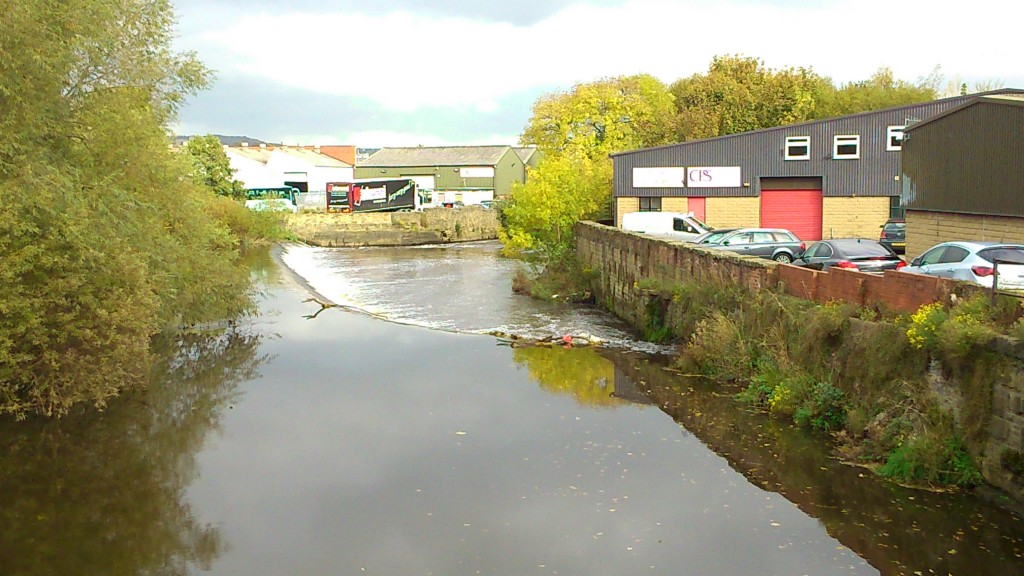 So would anyone miss this weir? One or two people expressed the view that, given the choice between it being there and not, they would rather it was, because at least it was something to look at. Which is fair enough. Other people, though, thought that it was rather unsightly to look at. There was no consensus on this. I did have one man explain in great detail to me why the weir had to be there to control the flow of the water round the curve in the river (all of which he was clearly making up, although he seemed quite convinced of his case). And another man seemd to think that the river level had been hollowed out on the downstream side, as opposed to artificially raised by damming on the upstream side. All of which will come as a surprise to engineers. But as I say, the point is that – basically – nobody seemed that bothered about this weir at all. This is a busy through road, not a beauty spot, and I was clearly a curiosity to most for even asking the question…
So would anyone miss this weir? One or two people expressed the view that, given the choice between it being there and not, they would rather it was, because at least it was something to look at. Which is fair enough. Other people, though, thought that it was rather unsightly to look at. There was no consensus on this. I did have one man explain in great detail to me why the weir had to be there to control the flow of the water round the curve in the river (all of which he was clearly making up, although he seemed quite convinced of his case). And another man seemd to think that the river level had been hollowed out on the downstream side, as opposed to artificially raised by damming on the upstream side. All of which will come as a surprise to engineers. But as I say, the point is that – basically – nobody seemed that bothered about this weir at all. This is a busy through road, not a beauty spot, and I was clearly a curiosity to most for even asking the question…
So, a curious afternoon all round really. But on a weirdly warm mid-October afternoon it was certainly pleasant to be out in the fresh air – even if those nagging fears about climate change won’t ever quite stop murmuring…
